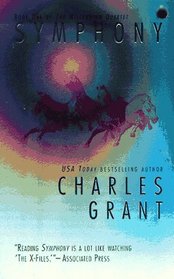From the back of the book:
Casey, a small town preacher, is losing his faith, yet suddenly he seems to be able to perform miracles. Are these gifts from God or sendings from an ancient Enemy?
Miles away, violence and death lie in the wake of a nondescript car whose inhabitants may not be completely human. Their journey will end in Casey's backyard.
When the preacher reluctantly takes up the battle against evil, his whole town is forced to shoose sides in the war between light and darkness. People's true natures are revealed as the battle lines are drawn and the countdown to the Millennium begins.
Casey, a small town preacher, is losing his faith, yet suddenly he seems to be able to perform miracles. Are these gifts from God or sendings from an ancient Enemy?
Miles away, violence and death lie in the wake of a nondescript car whose inhabitants may not be completely human. Their journey will end in Casey's backyard.
When the preacher reluctantly takes up the battle against evil, his whole town is forced to shoose sides in the war between light and darkness. People's true natures are revealed as the battle lines are drawn and the countdown to the Millennium begins.
Reading this book is a lot like watching the X files.
First volume in Grant's (In the Fog, 1993, etc.) millennial tetralogy about the Four Horsemen of the Apocalypse, this one focusing on the pale horseman Death. Far more adventurous than his story is Grant's form, which imitates the structure of a symphony. The effect seems rather feeble, though, when set beside Anthony Burgess's Napoleon Symphony: A Novel in Four Movements or Joyce's music chapter in Ulysses (``Bronze by gold heard the hoofirons, steelyringing''). Here, the small town of Maple Landing is about to witness, it would seem, the beginning of the world's end. A church bell tolls at night when no one is there to ring it--and, impossibly, only one bell of the three in the belfry rings. The altar crucifix, meantime, is coated with dead moths. Innocent young Dimitri sees a horse gallop about town that no one else can see, then hears large flocks of birds no one else hears. A crazy Bible-thumping woman warns everyone of the Lord's approaching vengeance. Following the worst winter in memory, folks at the Moonglow Diner speculate about the heavy heat, house fires, and water contamination. Reverend Casey Chisholm, a giant, hides a sorry past, but suddenly seems to have the ability to perform miracles. The rough beast slouching toward Maple Landing is a magnificent Lincoln Continental ``nearly as white and silent as the moon, silver horse in full gallop fixed on the hood.'' The shadowy driver within would seem to be a woman, accompanied by Lupâ, who can see werewolves, and by Stan Hogan, a vagrant of uncertain morality.
This book was like a condensed, reversed (bad coming to good instead of good going towards bad) version of Stephen King's "The Stand"; with bits of "Tommyknockers", "The Mist", and "The Gunslinger" thrown in. It wasn't bad, I just felt like I'd been there and done that. Perhaps if I hadn't read the aforementioned King books, I would have enjoyed it more.




